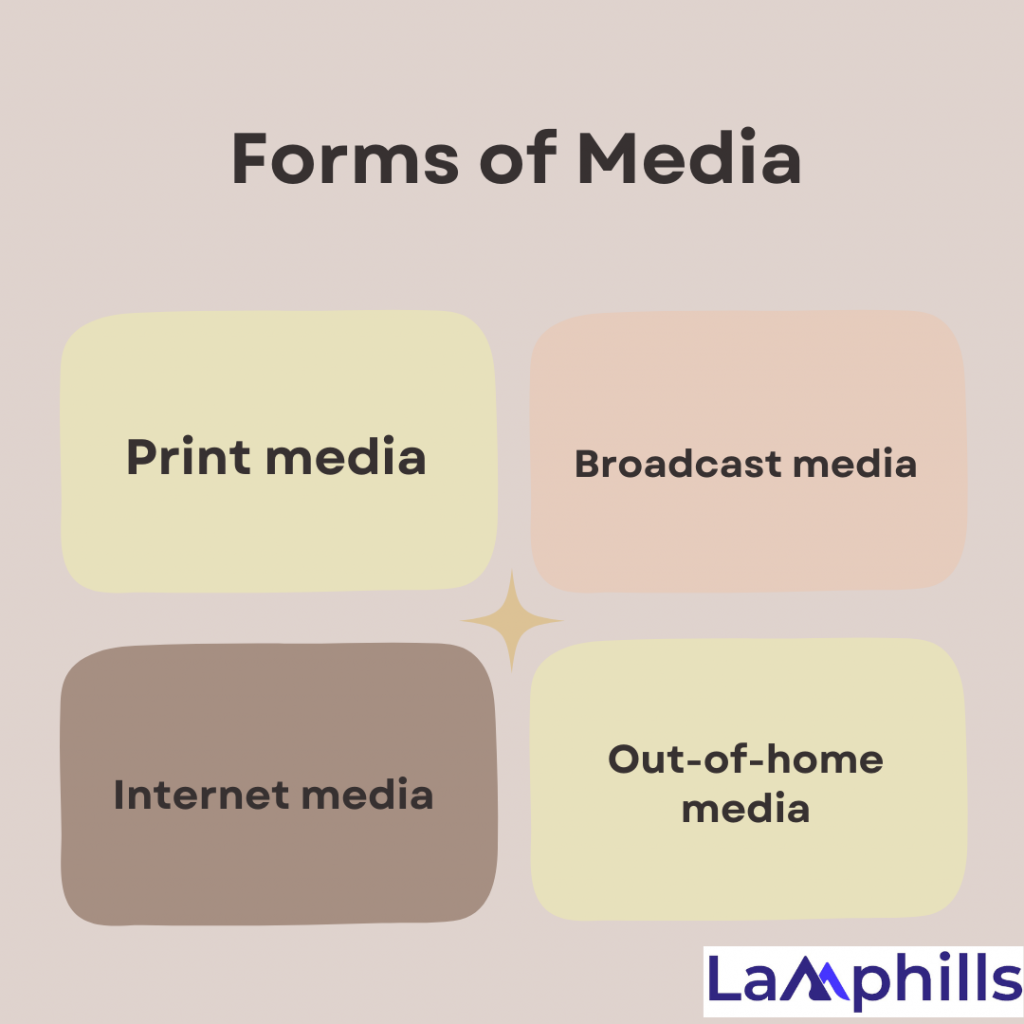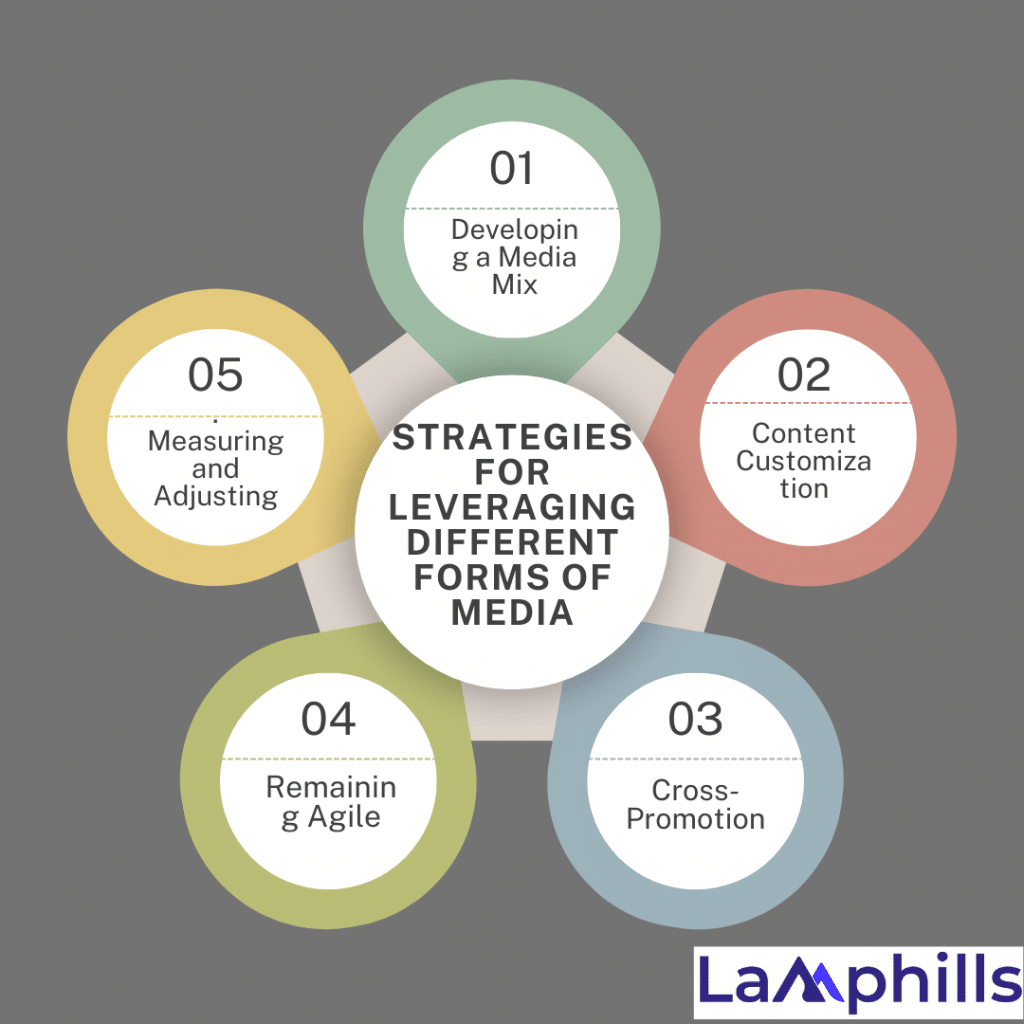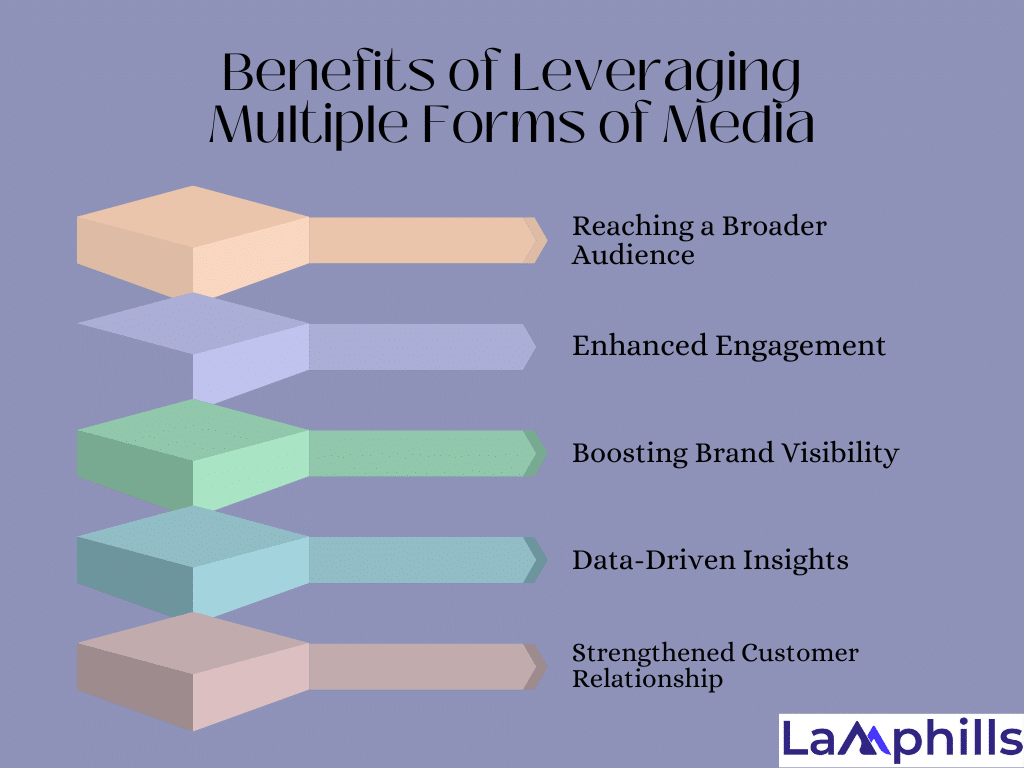I remember sitting in my grandfather’s living room, surrounded by the fragrance of old books and the soft buzz of his favorite radio station. He was a local company owner who relied mainly on print ads in the town newspaper and the occasional radio commercial to attract consumers to his hardware store. Back then, these traditional forms of media were the lifeblood of his marketing campaigns. Fast forward to now, and the media scene has drastically changed.
For example, a small café I always visited was able to survive and even prosper during the pandemic by utilizing social networking. They took to Instagram to display their wonderful pastries and comfortable setting, and their images quickly went viral, bringing in customers far beyond their local area. This story is a testament to how leveraging the right forms of media can drive significant business growth.
Key Takeaways
- Forms of media are described as the channels or methods used to store, transfer, or convey information or data. Examples are Newspapers, magazines, books, radio, television, cinema, the internet, social media, mobile phones, etc.
- Different forms of media cater to varied demographics and preferences. But by adopting a multi-channel approach, businesses can effectively engage a broader audience.
- Each media platform offers unique opportunities to engage audiences. Businesses can create richer and more interactive experiences by customizing content to fit the specific medium.
- The media landscape is constantly evolving with new platforms and technologies. So, staying updated with trends and being ready to adapt is crucial for long-term success.
Evolution of Media
Media has evolved alongside the advancement of human civilization and technology. The earliest forms of media were oral and written communication, such as stories, poems, letters, etc. Time, space, and audience all imposed limitations on these media types. The printing press, invented in the 15th century, permitted the widespread production and distribution of printed media such as books, newspapers, and pamphlets. These forms of media increased the media’s reach and power while also facilitating the dissemination of knowledge, culture, and ideas.
Electronic media such as the telegraph, telephone, radio, television, and cinema emerged throughout the nineteenth and twentieth centuries, respectively. These types of media allow audio and video signals to be transmitted and received across large distances and in real-time. These forms of media enhanced the speed, diversity, and interactivity of media and created a global media culture.
The internet, social media, mobile phones, and other forms of digital media have grown in popularity in the twenty-first century. These types of media allow for the creation, storage, access, and sharing of digital information and content in a variety of formats, including text, photos, audio, and video. These forms of media improve media connectedness, personalization, and participation while also empowering users to generate and consume media themselves.
Meaning and Definitions of Media
The term media is derived from the Latin word “medius,” which means “middle” or “intermediate.”. Media is described as the channels or methods used to store, transfer, or convey information or data. Media may also be defined as institutions or organizations that create and deliver information or entertainment to a general audience. Newspapers, magazines, books, radio, television, cinema, the internet, social media, mobile phones, and other forms of media are some examples. Education, entertainment, information, persuasion, advertising, marketing, and public relations are just a few of the uses of media.
Nature and Features of Media
The different forms of media can be characterized by the following nature and features:
- Media is dynamic and constantly changing with the advancement of technology and society.
- Media is diverse and offers a variety of choices and options for users and audiences.
- Media is interactive and allows the users and audiences to communicate and exchange feedback with the media and each other.
- Media is influential and affects the opinions, attitudes, behaviors, and values of the users and audiences.
- Media is powerful and can shape the public agenda, set the norms and standards, and create the reality and perception of the world.
- Media is ubiquitous and pervasive and can reach and impact people anywhere and anytime.
Factors to consider when selecting types of media
Selecting which forms of media your business will use depends on several factors, including:
- Your budget
- Size and nature of your business
- Your product or service
- Media availability
- Your marketing goals
Forms of Media and Its Importance

The forms of media are the different channels through which information and entertainment reach an audience. Media often includes the content itself as well as the physical device needed to transmit it, such as television programming and television. You can divide media into four distinct categories:
- Print media
- Broadcast media
- Internet media
- Out-of-home media
#1. Print Media

Print media encompasses physical publications like magazines, newspapers, and books, delivering information, news, and content in tangible formats.
Features:
- Tangible Engagement: Print media offers an actual reading experience, fostering deeper engagement with the content compared to digital alternatives.
- Extended Shelf Life: Printed materials can be collected, shared, and archived, retaining relevance over time, unlike digital media.
- Visual Presentation: High-quality visuals, graphics, and layouts enhance the presentation of information, contributing to a visually appealing reading experience.
Here are the different types of print media, along with the corresponding advantages and disadvantages of using them to communicate with customers:
A. Newspapers
Newspapers are traditional print publications that deliver news, articles, and commentary on current events, politics, business, and other topics to readers.
Features:
- In-depth coverage: Newspapers provide comprehensive coverage and analysis of local and global news stories, offering depth and context to readers.
- Tangible Format: The physical format of newspapers allows for actual reading and easy sharing of information among individuals.
- Diverse Content Sections: Newspapers typically include sections devoted to sports, entertainment, classifieds, and editorial opinions, catering to a wide range of interests.
News and other organizations create national, regional (local), or special interest newspapers and often distribute them daily. They disseminate an extensive amount of information at a low price to readers. Newspapers can include several ad types, such as classified ads, display ads and inserts.
Advantages of newspapers
- Large volume of readers: According to surveys conducted by the Pew Research Center, the data from 2018 indicates that 16% of adults got their news from a daily newspaper.
- High frequency: Most national and local newspaper organizations deliver daily.
- Inexpensive: Newspapers are usually $3 or less, and you can receive a discount if you pay for a yearly subscription.
- High level of reader engagement: Readers must decide to purchase a newspaper, and when they read it, it increases their level of engagement with the content.
- Geographic specificity: Ads can target a local or national audience.
Disadvantages of newspapers
- Possibility of becoming ruined: Printers use inexpensive, low-quality paper that becomes discolored and brittle.
- Inability to target specific demographics or lifestyles: Newspaper readers are a diverse population. Ads in newspapers cannot target specific genders, ages, hobbies, or economic classes.
- The short period of relevance: Most newspapers contain daily events and news that lose relevance within a day or two.
- audience must be able to read: Newspapers are only available for those who can read and those who have access to shops or delivery.
B. Magazines
Magazines are periodical publications covering various topics, offering curated content on news, entertainment, lifestyle, and specialized subjects.
Features:
- Curated Content: Magazines provide in-depth, curated content tailored to specific themes or interests.
- Visual Appeal: They offer visually appealing layouts and high-quality printing, enhancing the reading experience.
- Longevity: Magazines have a longer shelf life and collectible value compared to newspapers.
Magazines can be either consumer- or business-related. Consumer magazines cover topics such as glamour, lifestyle, entertainment, and particular interests. Consumer publications are often published every month. Business magazines, which may include trade journals and professional periodicals, convey news, information, reviews, and research about a given industry. Business magazines are often published on a monthly or quarterly basis.
Advantages of magazines
- Higher quality physical product: Magazine printers use glossy, higher quality paper than newsprint.
- Targeted lifestyles and demographics: Because magazine readership is segmented by gender, interest, or industry, advertisers can choose the most relevant publications.
- The long period of relevance and usefulness: magazines contain information and articles that can be useful for months or years, such as recipes, research, and informational pieces.
- High level of reader engagement: Readers are engaged in reading magazine articles, rather than being passive observers.
Disadvantages of magazines
- Low frequency: Magazine subscriptions often reach readers monthly. Other readers may purchase magazines inconsistently.
- Expensive: Advertising in magazines can be more expensive than advertising in newspapers.
- Competition: Many magazines have similar audiences, which leads to increased competition for reader attention and ad space.
C. Direct mail
Direct mail involves the physical delivery of promotional materials, such as letters, postcards, or brochures, directly to recipients’ mailboxes.
Features:
- Tangible Interaction: It provides a tangible, physical interaction with the audience, allowing recipients to physically handle and engage with the promotional materials.
- Personalized Messaging: Direct mail enables personalized and targeted messaging based on recipient data, increasing relevance and effectiveness.
- Longer Shelf Life: Compared to digital advertising, direct mail offers a longer shelf life, as recipients may keep physical materials for future reference or consideration.
Direct mail includes informational flyers or postcard promotions delivered via USPS to the home or business address of a specified list of customers.
Advantages of direct mail
- Highly specific audiences: Companies can pay for mailing lists filtered by zip code, income level, family size and more to reach individuals and families most likely to purchase products or services.
- Convenient and free for consumers: Customers do not have to make any extra effort to see your content.
- Opportunity for creativity: Direct mail provides an opportunity for advertisers to invoke creativity to gain readers’ attention.
- Personalization: Advertisers can personalize mail with recipients’ names.
Disadvantages of direct mail
- High cost of creation and demographic research: Direct mail can incur high costs if advertisers purchase extensive lists, send a large quantity, or use nontraditional sizes or shapes.
- Time requirement: Direct mail requires advanced planning for creation, printing, mailing, and delivery.
- Low response rate: Most direct mail recipients do not respond to mailers.
D. Books
Books are publications containing written content, available in physical or digital formats, including non-fiction works, novels, textbooks, and reference materials.
Features:
- Immersive Reading: Books offer an immersive, in-depth reading experience, allowing readers to delve into complex ideas and narratives.
- Tangible Format: They provide tangible, portable, and collectible formats, appealing to those who prefer physical copies.
- Exploration of Ideas: Books enable the exploration of complex ideas and narratives, fostering intellectual engagement and reflection.
Advantages:
- Emotional Connection: Books establish a strong emotional connection with readers, often leaving a lasting impact on their lives.
- Trusted Knowledge: They serve as trusted sources of information and knowledge, providing valuable insights and perspectives on various subjects.
- Distraction-Free Environment: Books offer a distraction-free, focused reading environment, allowing readers to immerse themselves fully in the content.
Disadvantages:
- Digital Competition: Books face competition from digital alternatives such as e-books and audiobooks, challenging traditional publishing models.
- Time Investment: Reading books requires a significant investment of time from readers, which may deter those seeking quick information or entertainment.
- Limited Interactivity: Books have limited opportunities for interactive or multimedia elements compared to digital formats, potentially limiting engagement.
#2. Broadcast Media

Broadcasting involves the transmission of audio and/or visual content, such as radio and television programs, to a broad audience via radio waves, cable, or satellite.
Features:
- Real-Time Experience: Broadcasting provides audiences with live, real-time access to news events and broadcasts, offering immediate delivery.
- Multimedia Engagement: Combining audio and visual elements, broadcasting creates immersive experiences that engage both listeners and viewers.
- Wide Reach: Broadcasting reaches a diverse audience across different demographics and geographic locations, fostering broad accessibility.
Here are the different types of broadcast media, along with the corresponding advantages and disadvantages:
A.Television
Television, the ultimate forms of visual media, transformed advertising by delivering moving visuals and music into people’s homes throughout the world. My first memories of memorable advertisements come from TV commercials that seemed larger than life, such as the legendary Coca-Cola commercials with catchy jingles and inspiring stories. These advertisements did more than just sell items; they also generated emotional connections and cultural moments.
Despite the rise of streaming services, television remains a powerful medium for reaching a large audience. Super Bowl advertisements, for example, are events in and of themselves, with businesses paying millions of dollars for a 30-second spot. Why? Because television can still capture and impact vast numbers of people at once.
Television is a medium that distributes audiovisual material, such as news, entertainment, and advertising, to viewers via broadcast, cable , or streaming platforms.
Features:
- Immersive Experience: Television provides an immersive audio-visual experience for viewers, engaging multiple senses.
- Wide Reach: It reaches a broad, diverse audience across different demographics and geographic locations.
- Live and Pre-recorded Content: Television offers both live, real-time programming and pre-recorded shows and events.
Television provides audiences with audio and visual stimuli to deliver information and entertainment.
Advantages of Television
- High viewership rates: Millions of viewers watch popular television shows or live events, like sports.
- Ads appear automatically: Viewers see ads without making any extra effort.
- Highly targeted to key demographics: Advertisers can use market research for time blocks, channels, and types of programs to target their desired audience.
- Flexibility: Television advertising allows for creative, emotional, or shocking methods for gaining viewer attention.
Disadvantages of television
- High cost: Television ads, especially those during popular shows and events, are expensive.
- Channel changing or fast-forwarding: Viewers have the option to skip your ad.
- Limited viewer attention: Viewers may experience distractions that prevent them from paying attention to your ad.
- Short ad lifespan: Television ads are typically 15, 30 or 60 seconds long.
B. Radio
Radio has long been a staple of the media world. It’s intimate and direct, engaging with listeners in their vehicles, homes, and workplaces. I recall hearing a nearby grocery store’s radio jingle every morning on the way to school. That catchy music burned the store’s name into my brain, and it wasn’t just me—radio can reach a large audience through repetitive messages.
Even now, radio is surprisingly durable. According to Nielsen, radio reaches over 90% of adults in the United States every week. Local companies can continue to use the radio to communicate with their communities. Consider a small-town diner marketing breakfast specials on the local station. It’s an effective way to reach morning commuters and encourage them to stop by for a bite. Radio offers listeners audio programming, including music, news, and podcasts.
Advantages of radio
- Low cost: Radio advertisements are typically cheaper than television ads.
- Flexibility: Advertisers can target listeners based on time, geographic location, channel, and program.
- Vast coverage: Radio programming has millions of listeners nationwide.
- Ability to reach low-income audiences: Many populations that may not have access to other mediums usually have radio access.
Disadvantages of radio
- Channel changing or fast-forwarding: Listeners may not pay attention to your ad.
- Short ad lifespan: Radio ads are typically 15, 30 or 60 seconds long.
- Less retention due to multiple ads airing consecutively: Radio ads appear in blocks, which could detract from listener retention.
- No visual elements: Relying only on audio content may diminish listener retention and response.
C. Movies
Movies provide opportunities for advertisers to incorporate their products outside of traditional advertising. The characters may mention or use a specific product due to an advertising deal between the movie studio and the company selling the product. For instance, many movies incorporate product placement of certain car or truck brands. Additionally, movie theaters often run ads just before showing a film.
Advantages of movie advertising
- Vast reach: Movie attendance, on average, includes over 1 billion viewers annually.
- Engaged audience: Moviegoers expect to pay attention.
- Capitalizing on the experience: Going to the movies provides a unique collective, emotional experience that advertisers can take advantage of.
- Limited distractions: Generally, movie theaters are free of loud noise, visual distractions, and background interruptions.
- Targeted geographic and age demographics: Advertisers can use market research to target audiences of certain movies by gender, age, and interests.
Disadvantages of movie advertising
- Low recall of ads or products: When products are placed in movies—or ads during the pre-show—they may be harder to remember.
- High cost: Movie cinema ads are expensive compared to print media ads.
- Low frequency: Audiences may not see movies as frequently at a cinema due to increased costs and competition from streaming services.
#3. Internet

The Internet is a global network that interconnects millions of computers worldwide, enabling users to access a vast repository of information, communicate in real time, and participate in many online activities.
Features:
- Instant Access to Information: Users can quickly retrieve a wealth of data and resources on virtually any topic with just a few clicks.
- Real-time Communication: Platforms such as email, messaging apps, and video conferencing tools facilitate immediate interaction and collaboration across distances.
- Interactive Platforms: Social media networks, e-commerce websites, and entertainment portals provide engaging platforms for socializing, shopping, and leisure activities.
Internet media refers to audio and visual content transmitted online. It can include words, images, graphics, and interactive elements. Here are some different types of internet media, along with the corresponding advantages and disadvantages:
A.Email
Email marketing is another digital force. It enables firms to contact customers directly through their inboxes. I recall subscribing to a newsletter from a local bookstore. Every week, I would get notifications on new arrivals and forthcoming activities. Those emails kept me in touch and frequently encouraged me to visit the store or make a purchase.
Email marketing is quite useful for organizations in terms of relationship building and conversions. A well-crafted email with a compelling offer can elicit a quick response. Consider an e-commerce business delivering a personalized discount code to a subscriber; this direct and personalized approach generally results in increased engagement and sales. Companies use email messages to reach customers quickly and directly.
Advantages of email
- Inexpensive: Sending and receiving a basic email is free.
- Easy to create: You can write an email to customers with a few simple lines. Several email marketing programs provide email templates and free images.
- Less research: Often, you won’t need to do extensive research for customer email addresses as customers provide them frequently at points of sale.
Disadvantages of email
- Low click-through rates: While many people may open your email, far fewer will click links to visit your site.
- Competition: Many companies use email marketing campaigns. Additionally, some email servers are identifying and filtering marketing emails.
- May feel intrusive to consumers: Customers may not remember providing their email address to you or accepting an agreement to receive emails. Be sure your email includes a link to unsubscribe from future emails.
B. Social media
Social media sites like Facebook, Instagram, and LinkedIn have transformed how businesses connect with their customers. I’ve personally witnessed how effective these platforms can be. My friend opened a small online business and utilized Instagram to exhibit her handcrafted jewelry. She created a devoted consumer base and increased her sales by publishing images regularly and connecting with her fans.
Social media is more than a marketing tool; it’s a method to build a community around your company. Nike, for example, uses social media to connect with their audience on a more personal level by presenting inspiring tales and interactive material that encourages followers to engage and share their own experiences.
Social media comprises online platforms and applications that enable users to generate, share, and interact with content while also facilitating connections with others.
Features:
- Real-Time Interaction: Social media fosters immediate, two-way communication and engagement among users.
- User-Generated Content: It allows users to build and share their content, contributing to a diverse and dynamic online environment.
- Targeted Advertising: Social media platforms offer advanced targeting options for advertisers, allowing for precise audience segmentation based on user data.
Social media is a crucial component of many companies’ marketing plans because of its popularity and longevity.
Advantages of social media
- Large audience: Billions of people use social media worldwide.
- Highly targeted ads: Companies can use the large amounts of data collected on users, like habits, purchase history, and friends.
- Can be inexpensive: Using social media organically to post and interact with customers can be free or very inexpensive.
- Interactive: Social media posts can have interactive capabilities for viewers, increasing engagement.
- Direct connection to consumers: Companies can use social media to speak directly to consumers in real-time.
- There is a large amount of performance evaluation data available: Advertisers can use several programs to monitor, track, and report on social media ad performance.
Disadvantages of social media
- Competition: Other companies seeking to reach your same audience may compete for the same ad space.
- User research can become expensive: The more in-depth your research, the more expensive it will be.
- Can feel intrusive to consumers: Customers may feel a lack of privacy when viewing highly targeted ads.
- Potential for negative comments: Open comments sections may include negative posts.
- Time-consuming: Building a brand and using social media effectively requires frequency, consistency, and a high level of responsiveness to gain followers.
C. Earned Media
Earned Media refers to publicity gained through non-paid promotional efforts, including word-of-mouth recommendations, media coverage, and social media mentions.
Features:
- Organic Exposure: Earned Media relies on authentic endorsements and recommendations from customers, influencers, or media outlets rather than paid advertising.
- Customer Endorsements: Positive reviews, social media shares, and testimonials from satisfied customers contribute to earned media exposure.
- Credibility Building: Third-party endorsements and media coverage enhance brand credibility and trust among target audiences.
Advantages:
- Brand Reputation Enhancement: Earned media generates positive exposure and brand recognition through genuine endorsements and recommendations.
- Cost-effective Exposure: Unlike paid advertising, earned media requires no direct monetary investment, making it a cost-effective way to reach and engage with audiences.
- Amplified Reach: Leveraging social proof and influencer partnerships can amplify brand reach and impact, driving awareness and engagement.
Disadvantages:
- Lack of Messaging Control: Brands have limited control over the content and messaging shared by external sources, which may lead to inconsistencies or misrepresentations.
- Monitoring and Management Needs: Consistent monitoring and management are necessary to address negative publicity or mitigate the impact of unfavorable mentions.
- Dependence on External Factors: The success of earned media efforts relies on factors such as customer satisfaction, media interest, and influencer engagement, making outcomes unpredictable.
D. Blogs
Blogs represent online platforms where individuals or organizations regularly publish chronological content, typically in the form of articles or posts.
Features:
- Personal Expression: They allow for the expression of personal perspectives and opinions, supporting individuality and diverse voices.
- Informal Tone: Blogs often adopt a more informal, conversational tone compared to traditional media, creating a relatable and engaging reading experience.
- Reader Engagement: They facilitate reader engagement through comments and social sharing, fostering community interaction and discussion.
Advantages:
- Cost-Effective Sharing: Blogs provide a cost-effective and accessible way to share information and ideas, enabling easy dissemination of content without significant financial investment.
- Thought leadership: They help establish the author as an expert or thought leader in a particular field, enhancing credibility and influence within the niche.
- Niche Targeting: Blogs offer opportunities for niche and specialized content targeting, allowing authors to cater to specific audience interests and preferences.
Disadvantages:
- Consistent Maintenance: Blogs require consistent content creation and maintenance to remain relevant and attract and retain readership over time.
- Credibility Challenges: They face challenges with credibility and trustworthiness compared to traditional media, as anyone can start a blog, raising concerns about accuracy and reliability.
- Standing Out: Blogs struggle to stand out in the crowded online landscape, where millions of blogs compete for attention, making it challenging to gain visibility and readership.
#4. Out-of-Home Media

Out-of-home (OOH) media reaches consumers where they spend their time outside, including city streets, highways, and transit stations. The following are types of OOH media, along with the corresponding advantages and disadvantages:
A. Billboards and Outdoor Signs
Billboards and outdoor signs may appear along busy streets, recreation centers, city sidewalks, and retail centers.
Advantages of billboards and outdoor signs
- Wide reach: In high-density areas, hundreds or thousands of people may see your ads.
- Inexpensive: Billboards and posters are cheaper than many other forms of advertising.
- Frequency: People who travel the same route or frequent the same locations see your ads regularly.
- Impactful messaging: Advertisers can use a small amount of space on a billboard or sign to create powerful statements that attract attention.
Disadvantages of billboards and outdoor signs
- Limited audience targeting: The audience for outdoor advertising is often less targeted, as advertisers cannot filter for demographics.
- Low response rate: While billboards and posters can remind consumers of your brand, they may rarely lead to action.
- Audience desensitization: If consumers see your ads daily for months, they may become desensitized to the message.
B. Transit Station Ads
You can find OOH media in bus stations, subway stations, train stations, and airports where there is always a lot of foot traffic. The advantages and disadvantages of these types of ads are similar to those of billboards and outdoor signs.
Advantages of transit station ads
- Wide reach
- Inexpensive
- Impactful messaging
Disadvantages of transit station ads
- Limited audience targeting
- Low response rate
- Performance is difficult to measure
Practical Steps for Implementation
Implementing a successful media strategy can seem daunting, but by breaking it down into manageable steps, you can navigate this journey with confidence. Here’s a detailed guide on how to practically apply the concepts of leveraging different forms of media for your business growth. I’ll share personal insights and examples to make these steps relatable and actionable.
#1. Audit Your Current Media Use
When I first launched my freelance writing firm, I conducted a media audit and discovered that, while my LinkedIn profile received a lot of traffic, my website had very few visits. This made me realize that I needed to improve the SEO of my website and generate more engaging blog content to attract and keep visitors.
In essence, before charting a new course, you must first comprehend where you are now. A media audit allows you to review your present media presence, discover what works well, and pinpoint areas for development. Consider it a health check-up for your company’s media strategy.
Why Audit? Conducting a media audit allows you to gain a comprehensive view of your current media efforts. For instance, you might find that your social media channels are thriving, but your website content needs an update. This insight is invaluable for making informed decisions about where to focus your resources.
Checklist for the Media Audit:
- List all media channels: Document all the platforms you currently use—website, social media, email newsletters, traditional ads, etc.
- Analyze Performance: Use analytics tools to assess each channel’s performance. Look at metrics like engagement rates, traffic, and conversion rates.
- Identify strengths and gaps: Determine which channels are performing well and which aren’t meeting expectations. For example, you might find that your Instagram has high engagement, but your blog posts aren’t getting much traffic.
- Assess Content Quality: Evaluate the quality and relevance of your content. Is it resonating with your target audience? Is it up-to-date and aligned with your brand’s voice?
#2. Define Clear Objectives
Setting clear, measurable goals is the foundation of a successful media strategy. Without specific objectives, it’s easy to get lost in the plethora of media options and end up with a disjointed approach.
Defining objectives helps you focus your efforts and measure success. Whether you aim to increase brand awareness, drive website traffic, or boost sales, having clear goals guides your strategy and helps you stay on track.
Aligning with Business Objectives: Your media goals should align with your overall business objectives. For example, if your business goal is to expand into a new market, your media strategy might focus on building awareness in that region through targeted ads and localized content.
#3. Create an Action Plan
With your audit insights and clear objectives in hand, it’s time to develop a detailed action plan. This plan will outline how you’ll achieve your media goals, manage resources, and track progress.
Step-by-Step Guide to Developing a Media Strategy:
- Identify Target Audience: Understand who you’re trying to reach. Create detailed audience personas, including demographics, preferences, and behaviors. For instance, if you’re a fitness brand targeting young professionals, your content should be geared toward their busy lifestyles and fitness goals.
- Select Media Channels: Choose the right mix of media channels based on your audience and objectives. If you’re launching a new product aimed at tech-savvy millennials, platforms like Instagram and YouTube might be more effective than traditional media.
- Budget Allocation: Determine how much you’re willing to spend on each media channel. Consider the cost-effectiveness and potential ROI of each platform. For example, you might allocate more budget to social media ads, which can offer highly targeted and measurable results.
- Content Creation: Develop content that resonates with your audience and fits each platform. If you’re promoting a new service, create engaging videos for social media, detailed blog posts for your website, and personalized emails for your subscribers.
- Timeline Setting: Establish a timeline for your media activities. Plan your content calendar,and schedule posts and campaigns to ensure a consistent and timely presence. For example, if you’re running a seasonal promotion, schedule your content to build anticipation and peak interest just before the launch.
#4. Measure and Adjust
Once your media strategy is in motion, it’s essential to monitor its performance and make adjustments as needed. This continuous improvement cycle helps you stay aligned with your goals and respond to changing circumstances.
So, Use analytics tools to track key performance indicators (KPIs) for each media channel. For example, monitor your website’s traffic and bounce rates with Google Analytics, and track engagement metrics on social media platforms.
Then be prepared to tweak your strategy based on performance data. If your Facebook ads aren’t generating the expected engagement, try testing different ad copy or targeting options. Conversely, if your email campaigns are performing well, consider expanding your efforts in this area.
#5. Stay Informed and Adapt
The media landscape is dynamic, with new platforms and trends emerging constantly. Staying informed about these changes and being willing to adapt your strategy is crucial for long-term success.
To keep up with trends: Follow industry news, attend webinars, and engage with thought leaders to stay abreast of the latest media trends. For example, the rise of short-form video content on platforms like TikTok and Instagram Reels represents a significant shift in how audiences consume content.
After that be ready to experiment with new formats and platforms. If you see a growing trend towards live streaming, consider incorporating it into your strategy. A local restaurant might start hosting live cooking demonstrations on Facebook to engage their audience and showcase their culinary expertise.
In other words, implementing a media strategy may appear complicated, but by taking these practical steps—conducting a thorough audit, setting clear objectives, developing a detailed action plan, continuously measuring and adjusting, and remaining adaptable—you can effectively harness the power of various media forms to drive business growth. Whether you run a small business or a major corporation, these ideas will help you navigate the changing media landscape with confidence and success.
Strategies for Leveraging Different Forms of Media

Harnessing the power of various media forms requires more than just understanding them; it involves strategically blending them to create a cohesive and impactful presence. Let’s dive into five essential strategies to effectively leverage different forms of media for business growth.
#1. Developing a Media Mix
Developing a well-balanced media strategy, often known as a media mix, is similar to creating the ideal dish. Each ingredient—traditional, digital, or emerging media—is critical to attaining the intended result. The idea is to blend these factors in a way that is relevant to your business objectives and appealing to your target audience.
To choose the right mix, consider where your audience spends their time. If you’re targeting young professionals, social media and digital advertising might be key. For an older demographic, traditional media like print and radio could be more effective. It’s also important to align your media choices with your business goals. For example, if you’re launching a new tech gadget, showcasing it through engaging video content on YouTube and tech blogs could generate buzz and drive sales.
#2. Content Customization
Each media platform has its own distinct audience and format, therefore, customizing your content to these specifics is critical. Just as you wouldn’t wear the same clothes to a beach party and a business meeting, your material should be tailored to each platform.
Let’s say you own a health and wellness company. On Instagram, you might publish bright photographs of your products in action, but on LinkedIn, you might provide extensive essays on health trends and industry insights. Customizing your content ensures that it resonates with the target audience on each platform.
In addition, repurposing content is a smart way to maximize your resources. A single blog post can be transformed into a series of tweets, an infographic for Pinterest, and a discussion topic for a podcast. For instance, a blog post about “10 Healthy Habits” can become a video series on YouTube, a detailed guide on your website, and social media snippets to engage different audiences.
Consider a fitness trainer who writes a blog post on “5 Tips for a Better Workout.” They can create short Instagram videos demonstrating each tip, post the full article on their website, and share motivational quotes from the blog on Twitter. This approach not only saves time but also extends the reach of their content across multiple platforms.
#3. Cross-Promotion
Cross-promotion entails leveraging one form of media to promote content on another, resulting in a seamless and integrated campaign. This method not only amplifies your message but also allows you to reach a larger audience by harnessing the strengths of numerous platforms.
Think of cross-promotion as being similar to a symphony, with different instruments playing together to create a harmonic performance. A new product introduction, for example, can be promoted using a combination of television advertisements, social media posts, and email newsletters. Each channel supports the other, resulting in a greater impact.
A local restaurant introducing a new menu may air a TV commercial highlighting their cuisine, share behind-the-scenes images on Instagram, and send a special offer to loyal customers via email. By combining these mediums, they generate a buzz that reaches various segments of their audience.
#4. Remaining Agile
The media world is continuously changing, as new platforms emerge and viewer preferences alter. Staying agile means being prepared to pivot and change your media strategy to remain relevant and effective.
Flexibility is critical. An approach that succeeded a year ago may not be as effective now. It’s critical to keep an eye on media trends and be open to trying out new formats and platforms. For example, the rise of TikTok has opened up new avenues for brands to reach younger audiences via short, entertaining videos.
During the COVID-19 pandemic, several firms had to immediately adapt their communication tactics. Restaurants began offering online cooking instruction and virtual tastings through streaming platforms. Gyms switched to online workout sessions. These agile adaptations helped them stay connected with their customers and even attract new ones during challenging times.
#5. Measuring and Adjusting
One of the most essential aspects of using various forms of media is to constantly assess the efficacy of your efforts and make appropriate adjustments. This iterative process ensures that your media strategy remains aligned with your objectives and produces the best results.
Analytics tools can help you track how your content performs across multiple platforms. Engagement rates, internet traffic, and conversion rates are all useful metrics for determining what works and what doesn’t. Google Analytics, for example, may show you which blog posts drive the most traffic to your website, whereas social network insights can disclose which posts generate the most engagement.
Prepare to adjust your strategies in light of these discoveries. If you have noticed that your Instagram posts are getting more traction than your Facebook posts, you might decide to allocate more resources to Instagram. Conversely, if a particular email campaign isn’t delivering the expected results, try adjusting your subject lines, content, or timing.
A friend of mine runs a small online boutique. She noticed that her email open rates were declining, so she tested different subject lines and found that personalized ones performed better. She also experimented with sending her emails at different times and discovered that her audience was more responsive to messages sent in the evening. These adjustments helped her improve her email marketing effectiveness significantly.
Using various forms of media is a continuous process that necessitates strategic planning, innovation, and adaptability. Businesses can use the power of media to generate growth and connect with their consumers in meaningful ways by building a balanced media mix, tailoring content, employing cross-promotion, remaining nimble, and constantly measuring and changing.
Benefits of Leveraging Multiple Forms of Media

In today’s fast-paced digital economy, harnessing different types of media is not simply a good idea; it is required for organizations to grow and survive. A multi-channel media strategy offers numerous benefits, including increased reach and useful information. Let’s take a closer look at the main benefits,
#1. Reaching a Broader Audience
One of the most compelling reasons to employ numerous forms of media is to reach a wide range of audiences. This is because each media outlet has its own distinct demographics and user base. You can attract the attention of different market segments by distributing your presence across multiple channels.
Consider how much my grandmother enjoys her morning newspaper, yet my teenage niece is obsessed with Instagram. They represent several age groups with diverse media tastes. Traditional media, such as print and radio, continue to be popular with older viewers, whilst newer generations prefer digital and social media platforms.
By adopting a multi-channel approach, businesses can engage these varied demographics effectively. For instance, a local coffee shop might advertise its new seasonal drinks through a mix of channels: running ads in the local newspaper for older readers, posting on Instagram and Facebook to engage younger customers, and sending out an email newsletter to loyal patrons. This ensures they’re reaching customers wherever they are, tailored to their preferences.
Take Coca-Cola as an example. They run ads on television to reach a broad audience, engage younger fans with catchy videos on TikTok, and maintain a strong presence on social media to interact with customers directly. This diverse approach helps them connect with a wide range of people globally, keeping their brand relevant across generations.
#2. Enhanced Engagement
Different media platforms provide distinct opportunities to engage and communicate with your target audience. Businesses may build richer and more immersive experiences for their customers by combining multiple platforms.
Imagine how a fashion company might utilize Instagram to provide visually appealing photographs of their new collection, YouTube to generate training videos demonstrating how to style ensembles, and Facebook to run interactive polls to solicit customer feedback. Each of these media formats uniquely engages the viewer, whether visually, informatively, or interactively. Interactive content is extremely effective in increasing engagement.
#3. Boosting Brand Visibility
Having a presence on different forms of media outlets can help your brand’s visibility and recognition. When clients see your brand consistently across many channels, it improves your brand image and encourages loyalty.
Picture a technology startup that has recently released a new app. They generate several touchpoints with potential customers by promoting their app through Google search ads, sharing user testimonials on their website, uploading engaging material on social media, and being featured in tech blogs. Every interaction strengthens the brand, making it more known and trustworthy.
The idea of media synergy comes into play here. It’s similar to how a symphony orchestra sounds better when all of the instruments play in harmony. When a business uses multiple media channels in a coordinated manner, the combined effect is greater than the sum of its parts. For example, a cohesive marketing campaign that includes TV ads, online content, and social media engagement can amplify the message and reach more people than any single channel could on its own.
Nike is a master of media synergy. Their campaigns seamlessly integrate television commercials, social media posts, and influencer partnerships. When they launch a new product, you might see a compelling TV ad during a sports event, followed by athlete endorsements on Instagram, and engaging stories on their website. This multi-channel presence keeps Nike at the forefront of consumers’ minds.
#4. Data-Driven Insights
Digital media, in particular, generates a lot of data that can help firms better understand their target audience and enhance their plans. These insights are extremely useful for making educated judgments and maximizing media efforts.
Tools such as Google Analytics, social media insights, and email marketing tools provide precise analytics on user behavior and interaction. For example, if you own an online store, you may monitor which products are most popular, how long visitors stay on your site, and where they leave off throughout the purchasing process. This information helps you understand what’s working and where you can improve.
These insights allow organizations to change their plans in real-time. For example, if a restaurant discovers its Instagram postings about brunch specials are getting more engagement than its dinner promotions, it might decide to focus more on promoting the brunch menu. Similarly, if email open rates are low, experimenting with different subject lines or sending times can lead to better results.
#5. Strengthened Customer Relationships
Using different media formats enables firms to develop and cultivate deeper consumer relationships. Each platform provides a distinct method to connect and communicate, promoting a stronger sense of involvement and loyalty.
Using many media channels allows for targeted communication tailored to the audience’s tastes. For example, a fitness firm may give individualized workout instructions to subscribers via email, engage followers on social media with inspiring fitness stories, and provide extensive product evaluations on their blog. This holistic strategy makes sure that every customer feels appreciated and connected to the business.
Consistent and meaningful interactions across multiple media formats contribute to trust and loyalty. When customers notice that a brand is active and engaged on social media, transparent in their blog content, and engaging through email, it strengthens their trust in the brand. For example, a company that consistently shares customer success stories and user-generated content creates a community where customers feel seen and appreciated.
Think about Apple’s approach. They use their website and YouTube to provide detailed product information and tutorials, run engaging ads on TV and online and maintain active social media profiles to interact with their customers. This comprehensive media presence not only showcases their products but also builds a loyal customer base that feels closely connected to the brand.
Finally, utilizing many forms of media has numerous benefits that can considerably improve a company’s growth and success. This is because businesses that effectively integrate conventional, digital, and new media may build a vivid, engaging, and dynamic presence that resonates with their target audience and fosters long-term success.
What are the most common forms of media?
What’s the most popular form of media? Digital media, such as the web, social media, and streaming media, typically reach more consumers than traditional forms of media.
Is music a form of media?
Music is one of the most popular and powerful forms of media that kids and teens consume.
What’s the difference between new media and traditional media?
New media refers to all types of media that rely on digital technology. Examples of new media include social media, internet ads, podcasts, video games, and streaming television and film. Traditional media refers to types of offline media that were popular before the internet, like billboards, live television, and print ads.
Conclusion
As you go over the information presented here, I encourage you to take the initial step toward improving your media strategy. Begin by analyzing your existing media usage—take note of all the platforms you’re using, analyze their performance, and discover places for improvement.
Include new forms of media in your plan. If you largely rely on traditional media, consider the benefits of digital platforms. If you’re already involved online, think about how developing media can benefit your business.
This is because utilizing different forms of media is an effective method for driving business growth, developing stronger connections with your audience, and preparing for future opportunities. Begin your journey now by analyzing your current media usage and creating clear objectives. and embracing new channels and technologies. The future of media in business is bright, and with the right strategy, you can harness its potential to propel your business forward.
References
- www.mentalhelp.net
- jgu.edu.in/blog
- www.geeksforgeeks.org
- www.indeed.com






